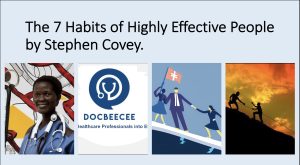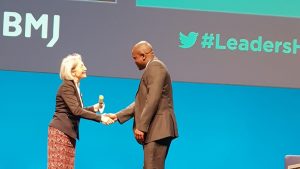By Dr Brighton Chireka
Every great success story is mostly the result of visionary leadership, collaborative working, and a passion for bringing about positive change. This story is no different. Recently I had the privilege of visiting this forested area in Kisumu , Kenya, that once had no first class hospital and was once deprived of electricity and saw firsthand how it was transformed. It’s amazing what can be accomplished when people come together with a common goal. In this case, we’ll take a look at how one visionary leader brought electricity to an area that had no electricity—and in doing so, turned it from a forest into a city. At first, people thought it was an impossible task, but this leader achieved the impossible and changed a community forever. We’ll also explore how collaboration and negotiation with local leaders to donate part of their land created a win-win situation that led to the construction of a hospital and the uplifting of the living standards of the community.
Leaders are often faced with the challenges of bringing positive change to their communities. This can be done through visionary leadership and collaborative working. Visionary leadership is the ability to look beyond the current state of a situation in order to see what could be. It involves understanding how different elements can come together and work collaboratively in order to achieve something greater. By collaborative working, I mean a situation when two or more people come together for a common goal. This type of leadership is essential for building a successful future, especially when it comes to bringing investment into a local community.
Mwale Medical and Technology City (MMTC)
MMTC is a USD $2 billion community owned sustainable city with 35,000 residents and is located in Butere Sub-County of Kakamega County in Kenya. It was founded by Julius Mwale and It’s the world’s first community owned sustainable green city that does not rely on the national grid power. The solar power plant is the main electricity source of the city . The construction of this city began in 2014 and was built through an integrated master development plan, where local land owners are not relocated from their land, instead they are integrated within the city, and their children employed in the City. The construction includes the 5000-bed Hamptons Hospital, Hamptons Shopping Mall, Hamptons Cafe & Bed & Breakfast, a 10MW solar plant supplying solar power throughout the city, 3500 solar streetlights, 150 km of improved roads, 36-hole golf course, 24- hour security, 4800 new homes and tourism circuit for tourists.
Recently MMTC had a major boost to its industrial district as Elon Musk’s Tesla company delivered containers of industrial grade solar power storage batteries from USA. These batteries have seen the Solar power plant upgrade from 1MW to 10MW and the aim is to eventually upgrade to 50MW. The delivered batteries can store thousands of Kilowatts of electricity which can run an entire City. These Tesla batteries have superior capacity to store the solar power captured by solar power panels, and feed it into the transformers. This guarantees that the power captured during the sunshine can be used 24 hours without being wasted. MMTC serves as proof of concept for the development of sustainable smart cities across Africa.
Visionary leadership of the Mwale family
Mr Julius Mwale is the investor of the Mwale Medical Technology City but this successful story starts with his father Abel Mwale. In the early 70s, Abel Mwaleconstructed the bridge and brought electricity into this forested area. The locals wondered why he was bringing electricity into the forest. His son, Julius took over the baton and transformed this forested area into a smart city. It is often said that the true measure of a successful leader is in the success of their successor. A leader without a successor is not truly successful, as there is no continuity or backup plan in place to protect an organisation’s future and stability. Leaders who prepare and mentor their successors are ensuring that their organisations are able to survive and thrive in the face of change. It goes without saying that Julius’ father instilled visionary and collaborative leadership skills into his son. Leadership has always been one of those rare positions where your legacy lives on after you have left your post—and this legacy should include more than just what you accomplished while you were there but also who you groomed and mentored during your time as leader so that your organisation can continue its success even when you’re gone.
I was impressed on my visit when the Project Manager, told me that Mr Julius Mwale has been involving his children in this successful project. His children are reported to have been part of this smart city at a very young age and are being prepared to carry on the button in the future. I have not yet had the privilege of meeting Mr Julius Mwale but I had the opportunity of meeting senior members of his team that included Honorable Dr. Maurice Siminyu the CEO. The senior team embodied the vision and values of MMTC and I felt the presence of Mr Julius Mwale by just interacting with his great team. It reminded me the quote by Lao Tzu, “A leader is best when people barely know he exists, when his work is done, his aim fulfilled, they will say: we did it ourselves”. His team is doing the work successfully and this to me is the mark of a successful leader.
Consulting Local Leaders: A Win-Win Situation
The first step towards bringing investment into this community was consulting with local leaders. This allowed Julius and his team to get community buy-in on the idea of building a hospital, as well as ensuring that they had the necessary resources—such as land—to make it happen. As such, some of the locals donated land for the hospital, making it possible for construction to begin. Julius Mwale has proved wrong those that thought as an investor, he was caring about making money. Those that donated part of their land had their properties upgraded and new modern homes were built for them to rent out. The locals have benefited from becoming landlords and can earn cash through renting out these buildings—providing them with a much needed source of income. Furthermore the locals now have access to high quality health care that has not have been available before. This means that locals are assured their families can now receive the best medical treatment available when needed. One local leader who was involved in this project said he now feels better off than he did before and can live longer because his community now has access to quality healthcare services. Additionally, many hospitals require additional staff onsite—meaning more jobs in the local community. As well as creating new employment opportunities, this also ensures that locals do not have to travel far or spend money on transport costs to receive medical attention and Kakamega county residents with National Health Insurance Fund (NHIF) are treated for free without incurring any shortfalls. Julius Mwale has also benefited too from collaborating with the local communities. Working with the local community ensured that construction processes run smoothly with fewer delays or complications along the way- which keeps budgets under control too. The local community are happy with what Julius Mwale has done and have positive relationship with him which shows that a win-win situation is possible.
Hamptons hospital
The hospital which is located in Kakamega County is a 5000-bed facility that is dedicated to providing high-quality, compassionate healthcare that gives a positive experience to all its patients. It opened in 2019 and is projected to treat 12,000 patients per day, or 4 million patients per year by 2024. The hospital offers a wide range of medical services, including primary care, surgery, diagnostic testing, and specialised care for a variety of medical conditions. The hospital is equipped with the latest technology and amenities to ensure a positive patients’ experience.
It has the most advanced radiology equipment in the region and advanced lab that can perform roughly 5,000 different tests. Most common ones include; Clinical chemistry, Serology, Microbiology/Parasitology, Haematology, Histology & Cytology, Genetics. It has another advance cancer and diagnostic wing which is currently open and receiving patients for Cancer screening, Cancer treatment, Pain management, Monoclonal antibodies and target therapies. The hospital currently hosts a technology and research park for artificial intelligence, Research & Development, Wearable biosensors and improved patient diagnosis. With the smart power system , the hospital will have advanced nuclear equipments like PET Scans and MRIs, putting Kenya’s globally as the centre of advanced healthcare.
The hospital is more than just a hospital. The team addresses the social determinants of health and are committed to the improvement of the overall health and wellness of the local community. They offer a variety of educational resources and programmes , including health fairs , support groups and fitness classes.
MMTC using Sustainable Solutions
When constructing new buildings such as hospitals, it’s important that sustainable solutions are put into place so that they remain viable long after they are opened up for use by the public. In terms of energy sources, solar energy is often preferable both due to its reduced environmental impact as well as its cost-effectiveness over time – not just for direct costs like power generation but also indirect costs such as maintenance or repair fees associated with other energy sources like gasoline or diesel fuel generators. The use of sustainable methods is also key in ensuring that any projects are successful in long-term development of communities. In this example, solar energy is being used to generate electricity for the entire hospital and community which allowed them access to electricity without harming the environment or draining resources from other areas. This type of sustainable development ensures that communities have access to clean energy sources for generations to come.
Conclusion
Everything falls and fails on leadership and leadership is about service. It is about honour and privilege to serve your community and MMTC is showing us how it can be done in a win- win way. We have seen how visionary leadership and collaborative working has been combined with great success -not only did it bring much-needed investment into a local community, but it also empowered the locals by providing sustainable energy sources along with opportunities for employment and technological advancements. When done correctly, visionary leadership and collaborative working can create amazing results as well as bringing confidence and hope – something that money simply cannot buy. This is why I highly recommend this model as the model for Africa that we have been waiting for and it’s time is now.

![]()



